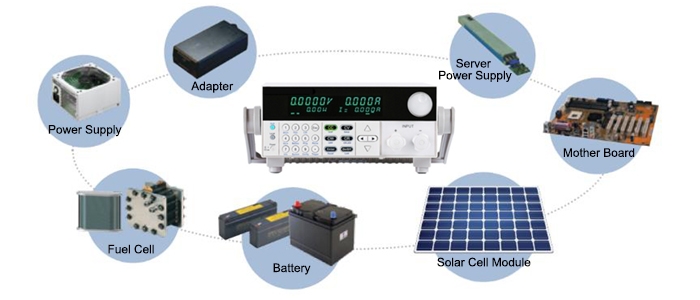In electronics, testing and validating power supply systems is crucial for ensuring that devices operate safely and efficiently. One essential tool for this purpose is an electronic load. This instrument simulates real-world load conditions by drawing a controlled current from a power source or battery under test. Unlike passive loads like resistors, which draw a fixed amount of current, electronic loads can dynamically adjust the current or voltage based on user inputs, providing much more flexible and accurate testing conditions.
How Does an Electronic Load Work?
At its core, a digital electronic load is a programmable device that can simulate different load scenarios such as constant current (CC), constant voltage (CV), constant resistance (CR), or constant power (CP). The electronic load can be used to test a variety of power sources including DC power supplies, batteries, solar panels, and power adapters.
Key Modes of Operation
- Constant Current (CC): In this mode, the electronic load will maintain a set current regardless of voltage fluctuations.
- Constant Voltage (CV): The load maintains a set voltage and adjusts the current drawn from the power source.
- Constant Resistance (CR): The load simulates a fixed resistance, drawing more or less current as the voltage changes.
- Constant Power (CP): The load draws enough current to maintain a constant power consumption, which can be useful when testing power supplies under specific load conditions.
Types of Electronic Loads
There are several different types of electronic loads, ranging from basic models to advanced versions with multiple programmable features.
- DC Electronic Loads: Primarily used for testing DC power supplies and batteries. These loads are widely used in consumer electronics testing, solar panel validation, and battery research.
- AC Electronic Loads: These are used for testing AC power supplies such as UPS systems, generators, and power inverters.
- Modular Electronic Loads: These offer flexibility by allowing users to configure different load modules into a single system, making it highly scalable.
Applications of Electronic Loads

Testing Power Supplies
One of the most common uses of an electronic load is to test power supplies. Power supplies, whether for computers, industrial equipment, or consumer electronics, must deliver a stable voltage and current to operate correctly. By applying different load conditions, engineers can test the power supply's performance, including its stability, efficiency, and response to varying loads.
For instance, testing a power supply under full load is a typical scenario in electronics labs. By using an electronic load, the power supply's output voltage and current can be carefully monitored and adjusted to ensure it operates within the specified range.
Battery Testing
Electronic loads are extensively used in testing batteries, especially lithium-ion (Li-ion) batteries that power most modern devices. Batteries need to be tested under various conditions, such as full charge, partial discharge, and rapid cycling, to ensure their longevity and safety.
When testing a 3000mAh lithium-ion battery, the electronic load can simulate real-world usage scenarios, such as a phone or a drone drawing power over time. Engineers can test how long the battery lasts under constant current draw or how it behaves when discharged at different rates.
Solar Panel Testing
Solar panels have to operate in a range of environmental conditions, from low-light to direct sunlight, and an electronic load helps simulate these conditions by dynamically changing the current draw. Testing a 100W solar panel under various conditions ensures that it produces the expected amount of energy in different environments. By using an electronic load in constant voltage mode, engineers can simulate the operation of a solar panel under real-world conditions, optimizing its performance.
Popular Power Ranges for Electronic Loads
Different power ratings of electronic loads are suited for specific applications, and these power levels often align with search trends and common testing scenarios:
- 150W to 300W Loads: Ideal for testing smaller power supplies, low-power battery packs, and USB chargers. These loads are perfect for hobbyists and small labs working with portable electronics.
- 500W to 1000W Loads: Suitable for testing larger devices like power bricks, server power supplies, and automotive electronics. Loads in this range are frequently searched for because they offer a good balance between capability and affordability.
- 1500W and Above: These high-power electronic loads are essential for testing industrial equipment, large solar arrays, and heavy-duty power sources. They are often used in automotive and aerospace industries for testing systems that require substantial current draw. Shop on sisco.com offers high-power electronic loads with capacities up to 6000W, making them ideal for demanding applications in industries requiring extensive testing power.
How to Choose the Right Electronic Load?
When selecting an electronic load, there are a few key factors to consider:
- Power Rating: Choose a load that can handle the maximum power you plan to test. For example, if you're testing a 600W power supply, you'll need an electronic load rated for at least 600W.
- Voltage and Current Ranges: Make sure the load supports the voltage and current ranges of the devices you're testing. Some loads support high current applications up to 120V or more.
- Programmability and Features: Advanced loads offer features like data logging, remote control, and protection modes (overvoltage, overcurrent, etc.), which can be essential for high-precision testing.
Electronic loads are indispensable tools for anyone involved in the design, development, or testing of power electronics. Whether you are working with power supplies, batteries, or solar panels, an electronic load provides the flexibility to simulate a wide range of real-world conditions. From 300W loads for small-scale electronics to 1000W or even 1500W loads for industrial applications, there’s an electronic load available for nearly every testing scenario. With the ability to operate in different modes such as constant current, voltage, resistance, and power, these digital electronic loads provide the accuracy and control necessary to ensure that power systems perform as expected.
When it comes to power electronics, using the right tools is key to ensuring reliability and performance—and an electronic load is one of the most valuable tools in that toolbox.

